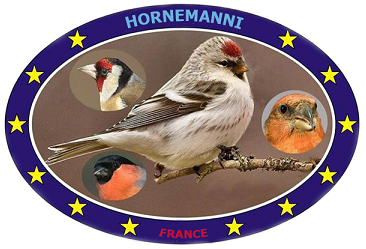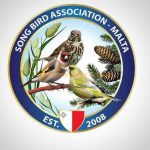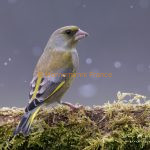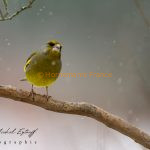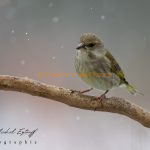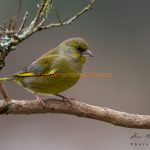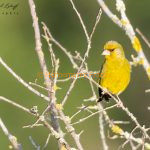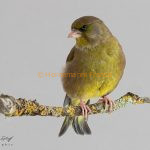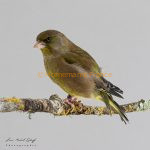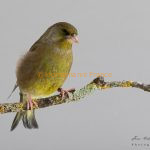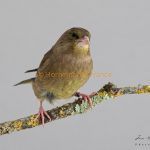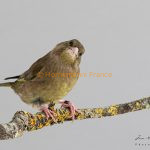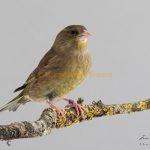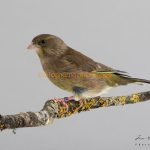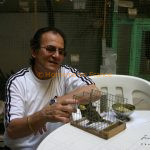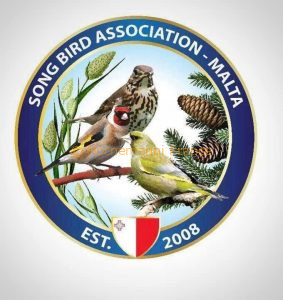
Photos Copyright : Jean-Michel EYTORFF
Maltese Greenfinch : breeder Roderick ABELLA
THE MALTESE GREENFINCH, A POSTURE GREENFINCH OBTAINED BY GENETIC SELECTION
Mutations do not only concern colour in birds. They can also be fixed and worked by selection on size or shape. By dint of perseverance, Maltese breeders have succeeded in breeding a greenfinch that no longer resembles the ancestral species found in the wild, the European greenfinch (Chloris chloris). My Maltese friends have kindly passed on to me the OMJ COM standard for the Greenfinch they have created, a domestic form that I will call the Posture Greenfinch, comparable to certain posture canaries such as the Norwich or Border. Logically, this form of Verdier should be listed as a domestic species under the regulations. With this in mind, UNICAB (Union Naturaliste pour les Intérêts de la Conservation Animale et de la Biodiversité) and I have asked the Ministry to review the list of domestic species, which has remained unchanged since 2006.
I would add that if you really want to get to know the Maltese Greenfinch, there’s only one solution: go and see it in Malta! Thanks again to our Maltese friends for sending us this document.
The photos of Maltese Greenfinches were taken when they left the aviary. In preparation for shows, they take on 30% more volume and are also much rounder.
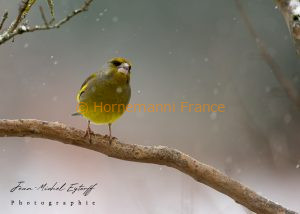
Male European Greenfinch (Chloris chloris)
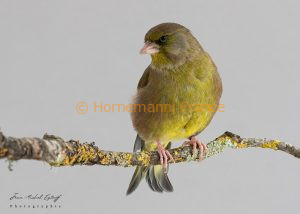
Male Maltese breeding Greenfinch (Chloris chloris)
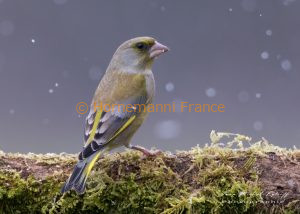
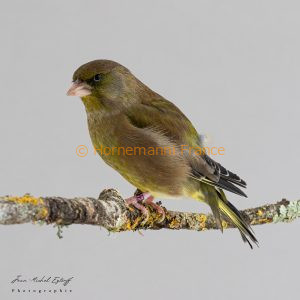
Male European Greenfinch (Chloris chloris)
Male Maltese breeding Greenfinch (Chloris chloris)

Male European Greenfinch subspecies Chloris chloris aurantiiventris (found in southern Spain, southern Europe and Greece)
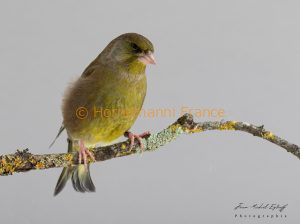
Male Maltese breeding Greenfinch (Chloris chloris)
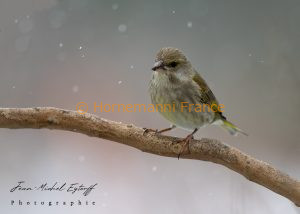
Female European Greenfinch (Chloris chloris)
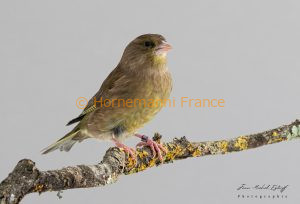
Female Maltese breeding Greenfinch (Chloris chloris)
Verdier Major
Exhibition standards
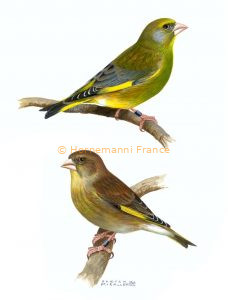
Size:
As large as possible, minimum 16.5cm.
Type:
Beak;
The beak should complement the shape of the head.
Head;
A broad, well rounded and well raised head, a prominent forehead, a well filled neck.
Body;
In profile, the bird should be harmoniously rounded from below the throat to the lower belly. Similarly, a convex curve is sought from the base of the neck to the rump. Should stand well up on the perch at an angle of approximately 45o.
Thighs;
Not visible.
Wings;
Close to the body, covering the upper tail. Should not cross or hang.
Tail;
Relatively short, tight and distinctly forked.
Colours and Markings
MALES:
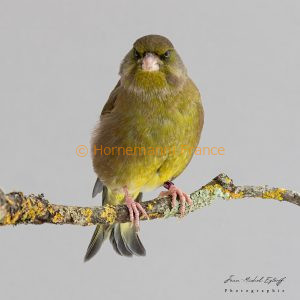
Beak;
Light flesh colour.
Eyes: Dark brown;
Dark brown.
Head;
Green forehead, dark lores.
Lighter green brow line.
Greenish brown cap and nape.
The moustache should be darker and more obvious. Grey ear patch.
Back;
Greenish brown with darker brown markings.
Rump;
Green, without contrast with the mantle.
The upper tail should gradually turn from olive green to greyish brown.
Lower belly;
Throat and chest should be a rich, bright green, as clear and solid as possible, blending into the yellow of the belly, with the white of the underbelly kept to a minimum.
The yellow under tail gradually fades to olive green.
Flanks;
Greenish brown.
Wings;
Primary remiges – should show rich yellow bars, forming a long mark on the lower tip of the folded wing.
Scapulars – green-brown, blending with the mantle.
Secondary wing feathers – black with grey borders, wider and brownish on the tertials.
Small upper wings – green.
Medium upper wings – olive green.
Primary tectrices – brownish grey.
Alula – bright yellow.
Tail:
Black showing bright yellow spots and a grey outer fringe.
The feathers in the centre of the tail will be black with a green border.
Legs and toes;
Flesh colour.
Nails;
Dark flesh colour.
FEMALES:
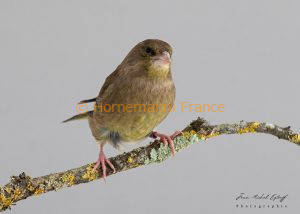
Type;
Same as male
Colour;
Vivid brownish and greenish hues. The yellow of the wings and tail will not be as extensive as in the male.
Beak;
Same as the male
Eyes;
Same as the male
Head;
Brown forehead tinged with green.
Lighter supercilium.
Cap and nape brown with darker markings.
The moustache should be darker brown and clearly visible.
Grey ear patch.
Back;
Brown with darker markings. The markings on the back should be in line, tapering towards the head and reaching to the rump.
Rump;
Green, the upper tail olive green to brown.
Lower belly;
Throat greyish brown with a green tinge.
The chest should be a light brown with a green tinge with darker markings.
The markings on the chest are broader and less obvious.
The belly is green to white around the lower belly.
The under tail is grey with a slight brown tinge.
Flanks;
Brown
Wings;
Scapulars – brown.
Primary remiges – blackish brown. A yellow border, thinner and less vivid than in the male.
Secondary wing feathers – blackish brown with greyish-brown borders.
Small upper wings – olive green.
Middle upper wings – olive green to brown.
Primary tectrices – black with a green border.
The alule – blackish brown with a yellow border.
Tail;
Black with yellow outer edge. The feathers in the centre of the tail will be blackish brown.
Legs and toes;
Flesh colour.
Nails;
Dark flesh colour.
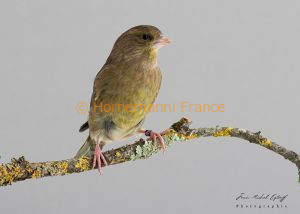



NOTE
Note on Size:
Even if larger specimens are preferred, size should not detract from the quality of colour and shape.
If the standard encourages the largest possible size, selection could lead to the presence of many defects: plumage, reduced fertility, weakened immunity. No aviculturist should contemplate the perpetuation of such defects by breeding birds with these traits.
Note on Type:
The head should not be angular or “boxy”. The forehead should be well defined, with a good rise from the upper mandible giving a well defined forehead. The skull should be broad in its upper roundness as well as towards the neck.
The body should be compact and round giving a robust, rounded appearance.
Note on Colour and Markings:
MALES :
Brownish tints on the head, back and flanks will not be considered faulty, but the bird showing a brighter green will be considered superior.
Schimmel birds show less colour than intensive birds. It is therefore less easy for a schimmel to win than the best intensives, even if it turns out that the schimmel wins because of superiority of type and size.
Note on Colours and Markings :
FEMALES
The white around the lower belly is more extensive than that of the male, often extending over the belly.
Well yellowed females will show plenty of colour on the chest and this, together with good performance in size and type, should lead to success. Schimmel females will often do better than yellows in their class but will be beaten by a yellow cock when it comes to competition for Best Greenfinch.
General notes:
The bird should show some pride and stand resolutely on its perch, staring out at its spectators.
If the intensives and schimmel are judged to be of equal merit, the yellow wins the day. If, however, the already well-coloured schimmel is superior as a type, it takes precedence.
DEFECTS
Faults of the Type:
Narrow skull. Poorly placed eyes. Beak too large or too small.
Especially to be avoided is a bird which presents the appearance of a straight line from the top of the head to the tail, a shape which is compared to “a ski slope” where the bird is “long”. This straight line can never allow for the rounded shape we’re looking for in this bird. Worse still: a hollow back.
Deformities, a pear-shaped bird, excess weight in the chest or lower abdomen resulting in poor posture. The bird should not be lying or crouching on the perch.
Poor wing carriage.
Colour defects and markings:
MALES
Colour impurities: discolouration or too much grey, leaving a too dark appearance.
Brown on chest and belly.
FEMALES
Too much white giving the impression of a pale bird.
General faults :
A bird that presents itself weakly, not very erect, not confident.
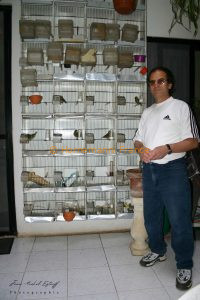
It was in 2005, at the World Championship in Bad Salzuflen, that I had the chance to discover and judge my first Maltese Greenfinches. That was all it took for me to go and meet Jimmy Zammit Fava, the Maltese breeder whose birds had won medals. It was a welcome I’ll remember for the rest of my life and the discovery of this posture greenfinch, of Scottish origin, which by selection had already become a bird of particularly impressive volume and size thanks to the passion of this breeder
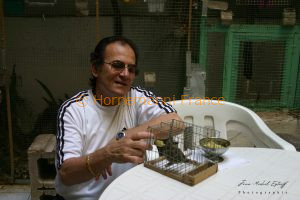
A Maltese greenfinch feeding during my visit.
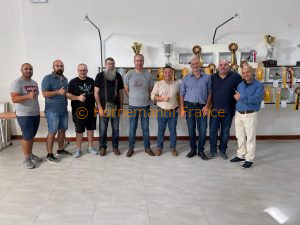
Much later, I was lucky enough to come and judge twice in Malta at the Song Bird Association exhibition. A friendship was born from these encounters. A particularly dynamic club of competitors that shines every year at the COM World Championships. Birds of a level rarely, if ever, seen in France.
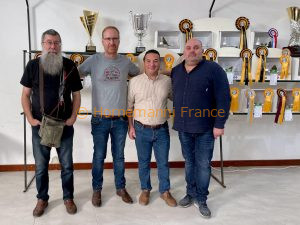
Souvenir of our last judging in 2022. Three French judges from the section judging this magnificent show, surrounded by Roderick, the best competitor in the Show. From left to right Jean-Luc, yours truly, Roderick, and David.

Best male Maltese Greenfinch Best in Show!
